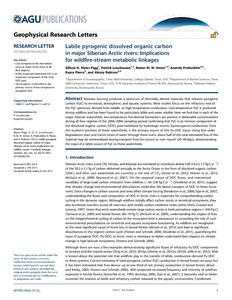Labile pyrogenic dissolved organic carbon in major Siberian Arctic rivers: Implications for wildfire-stream metabolic linkages
DOI:
10.1002/2014GL062762URI (для ссылок/цитирований):
https://elib.sfu-kras.ru/handle/2311/32922Автор:
Myers-Pigg, Allison N.
Louchouarn, Patrick
Amon Rainer, M. W.
Prokushkin, Anatoly
Pierce, Kayce
Rubtsov, Alexey
Коллективный автор:
Институт экологии и географии
Лаб. Биогеохимии экосистем
Дата:
2015-03Журнал:
Geophysical Research LettersКвартиль журнала в Scopus:
Q1Квартиль журнала в Web of Science:
Q1Библиографическое описание:
Myers-Pigg, Allison N. Labile pyrogenic dissolved organic carbon in major Siberian Arctic rivers: Implications for wildfire-stream metabolic linkages [Текст] / Allison N. Myers-Pigg, Patrick Louchouarn, M. W. Amon Rainer, Anatoly Prokushkin, Kayce Pierce, Alexey Rubtsov // Geophysical Research Letters. — 2015.Текст статьи не публикуется в открытом доступе в соответствии с политикой журнала.
Аннотация:
Biomass burning produces a spectrum of thermally altered materials that releases pyrogenic
carbon (PyC) to terrestrial, atmospheric, and aquatic systems. Most studies focus on the refractory end of
the PyC spectrum, derived from middle- to high-temperature combustion. Low-temperature PyC is produced
during wildfires and has been found to be particularly labile and water soluble. Here we find that in each of the
major Siberian watersheds, low-temperature fire-derived biomarkers are present in detectable concentrations
during all flow regimes of the 2004–2006 sampling period, confirming that PyC is an intrinsic component of
the dissolved organic carbon (DOC) pool mobilized by hydrologic events. Gymnosperm combustion, from
the southern portions of these watersheds, is the primary source of this Py-DOC input. Using first-order
degradation rates and transit times of water through these rivers, about half of the total estimated flux of this
material may be remineralized during transport from fire source to river mouth (20–40 days), demonstrating
the input of a labile source of PyC to these watersheds.

